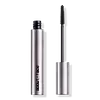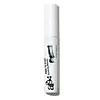What's inside
What's inside
 Key Ingredients
Key Ingredients

 Benefits
Benefits

 Concerns
Concerns

 Ingredients Side-by-side
Ingredients Side-by-side

Water
Skin ConditioningOryza Sativa Bran Wax
Skin ConditioningBehenyl Alcohol
EmollientCI 77499
Cosmetic ColorantPalmitic Acid
EmollientStearic Acid
CleansingAcacia Senegal Gum
MaskingCopernicia Cerifera Wax
Styrene/Acrylates Copolymer
Butylene Glycol
HumectantAminomethyl Propanediol
BufferingCocos Nucifera Oil
MaskingVp/Eicosene Copolymer
Glyceryl Stearate
EmollientPhenoxyethanol
PreservativeOleic/Linoleic/Linolenic Polyglycerides
EmollientMicrocrystalline Cellulose
AbsorbentEthylhexylglycerin
Skin ConditioningPanthenol
Skin ConditioningTocopheryl Acetate
AntioxidantRicinus Communis Seed Oil
MaskingCellulose Gum
Emulsion StabilisingSodium Dehydroacetate
PreservativeCitric Acid
BufferingDextran
Acetyl Tetrapeptide-3
Skin ProtectingTrifolium Pratense Flower Extract
AstringentWater, Oryza Sativa Bran Wax, Behenyl Alcohol, CI 77499, Palmitic Acid, Stearic Acid, Acacia Senegal Gum, Copernicia Cerifera Wax, Styrene/Acrylates Copolymer, Butylene Glycol, Aminomethyl Propanediol, Cocos Nucifera Oil, Vp/Eicosene Copolymer, Glyceryl Stearate, Phenoxyethanol, Oleic/Linoleic/Linolenic Polyglycerides, Microcrystalline Cellulose, Ethylhexylglycerin, Panthenol, Tocopheryl Acetate, Ricinus Communis Seed Oil, Cellulose Gum, Sodium Dehydroacetate, Citric Acid, Dextran, Acetyl Tetrapeptide-3, Trifolium Pratense Flower Extract
Water
Skin ConditioningIron Oxides
Synthetic Beeswax
Emulsion StabilisingPvp
Emulsion StabilisingPalmitic Acid
EmollientCopernicia Cerifera Wax
Styrene/Acrylates Copolymer
Glyceryl Stearate Se
EmulsifyingMicrocrystalline Wax
Emulsion StabilisingButylene Glycol
HumectantHelianthus Annuus Seed Oil
EmollientRicinus Communis Seed Oil
MaskingAminomethyl Propanediol
BufferingButyrospermum Parkii Butter
Skin ConditioningPolyurethane-35
Cellulose
AbsorbentPhenoxyethanol
PreservativePrunus Amygdalus Dulcis Oil
Skin ConditioningVegetable Oil
Skin ConditioningHydroxyethylcellulose
Emulsion StabilisingCaprylyl Glycol
EmollientAcacia Senegal Gum
MaskingArginine
MaskingXanthan Gum
EmulsifyingAlgin
MaskingEthylhexylglycerin
Skin ConditioningHexylene Glycol
EmulsifyingMyristic Acid
CleansingStearic Acid
CleansingTocopherol
AntioxidantCaesalpinia Spinosa Fruit Extract
Skin ProtectingLauric Acid
CleansingHydrolyzed Wheat Protein
Skin ConditioningTriticum Vulgare Starch
AbrasiveSodium Acetate
BufferingKappaphycus Alvarezii Extract
Skin ConditioningIsopropyl Alcohol
SolventPanthenol
Skin ConditioningBenzyl Alcohol
PerfumingPotassium Sorbate
PreservativeSodium Benzoate
MaskingWater, Iron Oxides, Synthetic Beeswax, Pvp, Palmitic Acid, Copernicia Cerifera Wax, Styrene/Acrylates Copolymer, Glyceryl Stearate Se, Microcrystalline Wax, Butylene Glycol, Helianthus Annuus Seed Oil, Ricinus Communis Seed Oil, Aminomethyl Propanediol, Butyrospermum Parkii Butter, Polyurethane-35, Cellulose, Phenoxyethanol, Prunus Amygdalus Dulcis Oil, Vegetable Oil, Hydroxyethylcellulose, Caprylyl Glycol, Acacia Senegal Gum, Arginine, Xanthan Gum, Algin, Ethylhexylglycerin, Hexylene Glycol, Myristic Acid, Stearic Acid, Tocopherol, Caesalpinia Spinosa Fruit Extract, Lauric Acid, Hydrolyzed Wheat Protein, Triticum Vulgare Starch, Sodium Acetate, Kappaphycus Alvarezii Extract, Isopropyl Alcohol, Panthenol, Benzyl Alcohol, Potassium Sorbate, Sodium Benzoate
Ingredients Explained
These ingredients are found in both products.
Ingredients higher up in an ingredient list are typically present in a larger amount.
Acacia Senegal Gum has skin soothing, thickening, and formulation stabilizing properties. It comes from the Acacia tree that is native to sub-Saharan Africa.
We don't have a description for Aminomethyl Propanediol yet.
Butylene Glycol (or BG) is used within cosmetic products for a few different reasons:
Overall, Butylene Glycol is a safe and well-rounded ingredient that works well with other ingredients.
Though this ingredient works well with most skin types, some people with sensitive skin may experience a reaction such as allergic rashes, closed comedones, or itchiness.
Learn more about Butylene GlycolCopernicia Cerifera Wax comes from a palm tree native to Brazil; another name for this ingredient is Carnauba Wax.
This ingredient is used to thicken texture and also leaves behind a film when applied.
Fun fact: This wax has the highest melting point of all natural waxes and low solubility.
Learn more about Copernicia Cerifera WaxEthylhexylglycerin (we can't pronounce this either) is commonly used as a preservative and skin softener. It is derived from glyceryl.
You might see Ethylhexylglycerin often paired with other preservatives such as phenoxyethanol. Ethylhexylglycerin has been found to increase the effectiveness of these other preservatives.
Palmitic Acid is a fatty acid naturally found in our skin and in many plant and animal sources. In cosmetics, it is usually derived from palm oil. It serves many purposes in skincare, acting as a cleanser, emollient, and emulsifier.
As an emollient, palmitic acid helps soften and smooth the skin by preventing water loss. In cleansers, it helps remove oil and dirt while creating foam.
Its emulsifying properties help stabilize products by keeping water and oil-based ingredients from separating.
This may not be suitable for fungal acne-prone skin, as fatty acids like this can sometimes trigger breakouts in sensitive individuals.
Learn more about Palmitic AcidPanthenol is a common ingredient that helps hydrate and soothe the skin. It is found naturally in our skin and hair.
There are two forms of panthenol: D and L.
D-panthenol is also known as dexpanthenol. Most cosmetics use dexpanthenol or a mixture of D and L-panthenol.
Panthenol is famous due to its ability to go deeper into the skin's layers. Using this ingredient has numerous pros (and no cons):
Like hyaluronic acid, panthenol is a humectant. Humectants are able to bind and hold large amounts of water to keep skin hydrated.
This ingredient works well for wound healing. It works by increasing tissue in the wound and helps close open wounds.
Once oxidized, panthenol converts to pantothenic acid. Panthothenic acid is found in all living cells.
This ingredient is also referred to as pro-vitamin B5.
Learn more about PanthenolPhenoxyethanol is a preservative that has germicide, antimicrobial, and aromatic properties. Studies show that phenoxyethanol can prevent microbial growth. By itself, it has a scent that is similar to that of a rose.
It's often used in formulations along with Caprylyl Glycol to preserve the shelf life of products.
Ricinus Communis Seed Oil is the INCI name for castor oil.
Castor Oil helps moisturize the skin. It is rich in a fatty acid called ricinoleic acid. This fatty acid helps prevent moisture loss on the skin. This helps keep your skin soft and hydrated. Ricinoleic acid also has anti-inflammatory and pain reducing properties.
Besides hydrating the skin, castor oil is also used to hydrate hair. By keeping the hair shaft moisturized, breakage is decreased. More studies are needed to show castor oil's effective on stimulating hair growth.
Castor oil is created by cold-pressing castor seeds and then purifying the oil with heat. It was used in Ancient Egypt as fuel in lamps and to help treat eye irritation.
The term 'fragrance' is not regulated in many countries. In many cases, it is up to the brand to define this term. For instance, many brands choose to label themselves as "fragrance-free" because they are not using synthetic fragrances. However, their products may still contain ingredients such as essential oils that are considered a fragrance.
Learn more about Ricinus Communis Seed OilStearic Acid is a fatty acid. It is an emollient, emulsifier, and texture enhancer.
As an emollient, stearic acid helps soften skin. It aids the skin's protective barrier by preventing water loss. It also provides a gentle cleansing effect without stripping away natural oils.
Stearic acid may also be used to enhance the texture of products. It can add volume and stabilize ingredients such as water and oil. This can help water and oil ingredients from separating.
Sources of stearic acid include animal or vegetable fats/oils such as coconut or shea. It can be naturally found in butter, cocoa butter, shea butter, vegetable fats, and animal tallow.
This ingredient may not be Malassezia folliculitis, or fungal-acne safe.
Learn more about Stearic AcidWe don't have a description for Styrene/Acrylates Copolymer yet.
Water. It's the most common cosmetic ingredient of all. You'll usually see it at the top of ingredient lists, meaning that it makes up the largest part of the product.
So why is it so popular? Water most often acts as a solvent - this means that it helps dissolve other ingredients into the formulation.
You'll also recognize water as that liquid we all need to stay alive. If you see this, drink a glass of water. Stay hydrated!
Learn more about Water